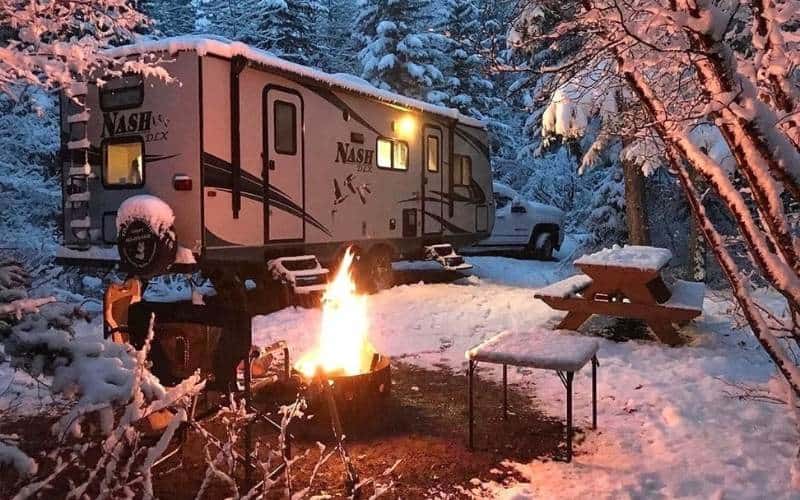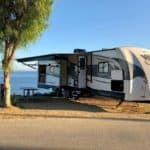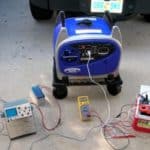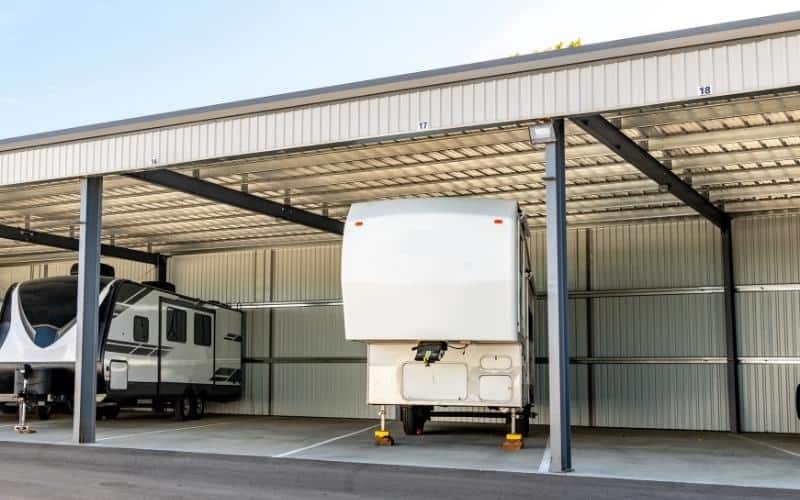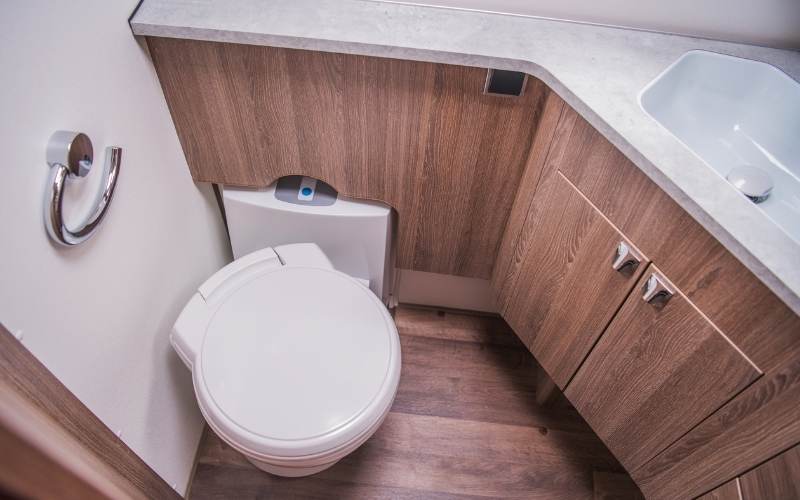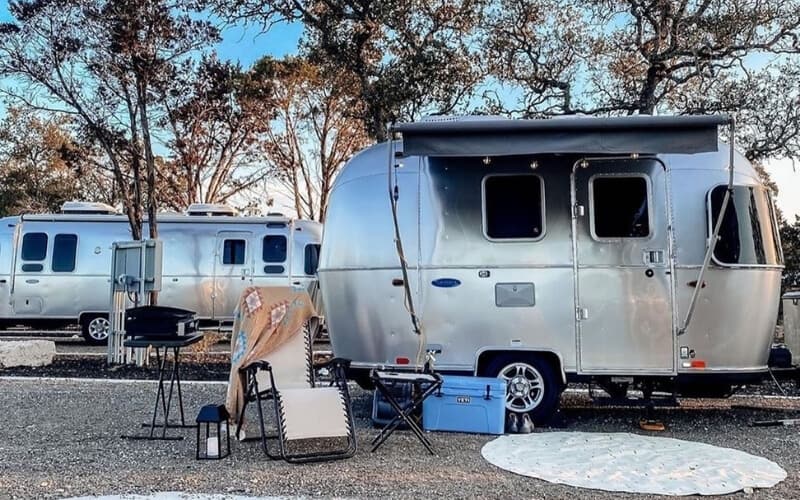Modern Propane systems can come with a steep price tag, and sometimes the thought of having an active gas line mix with a moving vehicle makes it seem too dangerous to heat your RV to be worth it.
Luckily, you don’t have to cancel your trip plans at the first sign of inclement weather. If you want to enjoy a toasty RV interior without relying on propane, there are a variety of options for you.
We combed through countless remedies, quick fixes, and permanent options and found these to be a few of the best and most efficient techniques to heating an RV without Propane while boondocking in the middle of nowhere:
There’s no point bringing an RV with you into the wild if you’ll still spend the night shivering but the best thing is You don’t need propane to keep warm in an RV while camping in the freezing cold winter months.
The solutions on this list require varying degrees of financial investment, time commitments, and effectiveness.
Read on to find out which one of these ways to heat an RV without propane are best for you.
Tips To Survive In RV In The Winter Without Propane
Sometimes, you don’t have the luxury of the perfect solution. Fickle weather patterns can easily sneak up on us, especially when in the mountains.
The most beautiful nights spent in our RV’s are often in remote areas, and when the weather turns south fast, all you can do is react.
The following are a variety of methods you can employ in an emergency scenario.
Use these tips to keep your hands warm enough all night to grip the steering wheel in the morning, and then high-tail it to the nearest big box store for a portable heater and a cup of hot coffee.
1: Vehicle Heater
Using the vehicle heater uses up precious gasoline, which means this is the last resort option.
Crank the keys, and turn your car’s heater all the way up for half an hour right before you plan on going to sleep. Give yourself a much-needed heat boost and get comfy.
The biggest concern with this method is getting too comfortable. Fall asleep with the vehicle heater on, and you could wake up in the morning with a dead battery or empty fuel tank.
Keep someone on watch or set an alarm to avoid a bad situation becoming much worse.
2: Stay Warm With A Hot Water Bottle
Using your cooking source as a standalone heater is too dangerous, as open flames or noxious gas left unchecked ends vacations in a hurry.
You can channel your cookstove’s healing energy into boiling water, which can quickly heat your body if used quickly.
This method won’t heat your entire vehicle, but a non-insulated water bottle filled with boiling water will put off enough thermals to get you to sleep.
Simply fill up a bottle with hot water, cover the bottle in a sock, and tuck it deep inside your blankets to help preserve the heat. This short-term solution is best if you are by yourself.
3: Covering The Windows
You’re better off handling your insulation before you leave your driveway, but sometimes beggars can’t afford to be choosers.
Most of your RV’s heat will be escaping through any doorways and windows in your sleeping compartment, and any heat you do generate will leave quickly if you don’t act.
If you find yourself in a colder night than you expected, it’s too late for a fancy job. Find extra towels, blankets, or any piece of thick cloth, and secure it tightly across all windows or gaps in your RV.
Protecting your windows will trap more heat inside your vehicle and give you a better chance at heating up the situation.
4: Start Driving
If nothing else is working, it’s okay to admit defeat. Don’t stay out in the cold stubbornly expecting things to change.
The coldest part of the night is just before dawn, so if you’re struggling to keep warm and the night is still young, spending the night where you are might not be in the cards.
Being cold can ruin an entire trip. Nobody wants to do anything when they’re freezing besides warm-up, and you’re relaxing vacation could turn into a shivering puddle.
It’s worth spending a few extra bucks on an electricity source or hotel room if you can’t find comfort.
If you’re on top of a mountain or in an area exposed to wind, a quick drive towards a protected area could do wonders for your RV’s temperature, plus it will give you time to blast the heat without draining the battery.
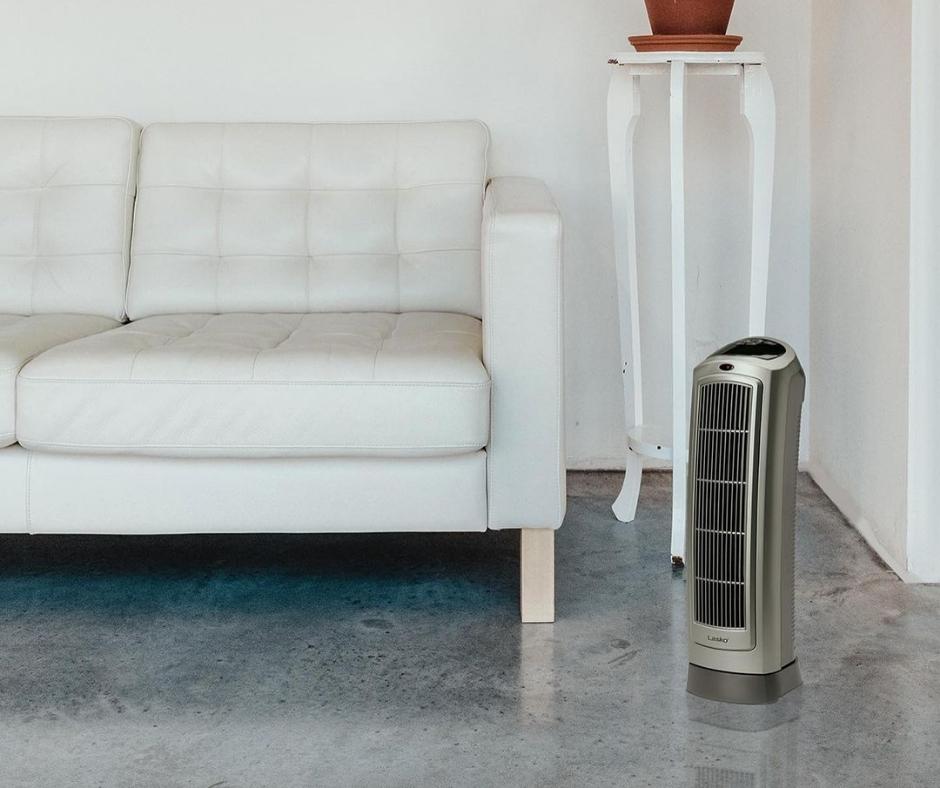
5 Most Efficient Ways To Heat An RV Without Propane
Method 1: Use A Portable Heater built for Boondocking
One of the best methods for heating your RV propane-free is a simple yet effective upgrade to your interior.
You can purchase Portable Heaters in a jiffy, and the system doesn’t require a trip to a mechanic or months of planning to get set up.
Plugging in A Cheap, Portable Space Heater
If you want to heat your RV without propane, connecting to a portable space heater is an inexpensive way to get warm.
Technology has come a long way, and cheap products like this Ceramic Space Heater will quietly heat an entire Class B camper efficiently.
A portable electric heater will provide safe, long-lasting artificial heat to help get you through colder nights.
This choice is the cheapest RV heating solution out there, but I don’t think that means it won’t get the job done.
It’s also an incredibly convenient option, as you’ll be able to find a portable heater in most general stores.
Treat your portable heater the same as if it was operating in a house. Ensure you properly clear out the necessary space to give your mobile heater room to work.
For Weaker Electrical Set-Ups, Try Battery-Powered Portable Heaters
Batteries alone struggle to keep up with the high electrical demand of most portable heaters.
However, like refrigerators, new options are starting to allow RVers more choice when deciding how to power their comfort.
Portable Heaters that hook up to your 12V battery system directly are now capable of pumping out enough heat for a good night’s sleep.
The most advanced options can churn out 13,200 BTUs per hour while remaining a low-cost solution to your energy needs.
Battery-powered portable heaters are frequently designed for RV usage, giving them more features that fit into a mobile lifestyle.
These heaters are built to last and are capable of bouncing around without damage.
Find the best way to Power your Propane Free Portable Heaters
The catch with this RV heating solution is its energy cost. Travelers using portable heaters will be asking a lot out of their battery system.
Upgrading your battery bank should already be on the minds of any RV owner, and perhaps the incentive of having a warm place to sleep will be enough to commit to an upgrade.
Add on Extra Batteries in Parallel To Provide Extra Run Time
Simply connect a second battery to your existing coach system to instantly double your reserve.
The second battery can quickly become a third and fourth, and you’ll find yourself with a system built to last. Be sure to find batteries that play well together.
Shore Power or Generator Are Battle tested Solutions
You may be most comfortable spending the coldest nights in your camper at campgrounds with shore power.
Any campsite with a 30 amp plug-in will allow you to run your heater all night long. If you want to Boondock in a cold area, invest in a portable generator.
Mount Solar Panels For Constant Recharge
Don’t rely on your alternator to keep your batteries charged.
If you want to be off the grid for a few nights without having to drive, hooking a few solar panels onto your roof will keep your battery bank topped off and the heater running.
Investing in high-quality solar panels will give you energy through cloudy afternoons.
Method 2: Invest in a Permanent RV heating solution
These technologies require high up-front commitment to keep your RV warm.
Most of these solutions are best done while building out your RV or by a professional. Once you have done the hard work, you’ll have an unlimited supply of efficient heat.
Hydronic Heating System Provides a High Tech Solution
New high-end RVs may come with this feature already inside the walls of their RV’s.
The energy-efficient system heats a mixture of water and antifreeze in small radiators that you can permanently place out of the way inside your camper.
The energy to heat this system is heated by the engine when you drive and then by diesel fuel when in park.
If you know you will be headed through cold areas, put this heating system on your wishlist when looking for campers.
It can be installed aftermarket but is best left to a Hydronics professional.
The difficulty of installation scares owners away, but consider this source if you’re willing to put in significant upfront investment.
Combine your A/C with a Heat Pump
A high-quality A/C system can also go in the opposite direction, heating your RV with a pump system built into the product.
This option is great for RV owners who are also considering installing an A/C unit.
This option’s power will come from your battery or generator but at a significantly smaller clip than a portable electric heater.
You can hook it up to your roof to save valuable floor space and have faith that this heat source will be working for years to come.
Keep your Toes Warm with Radiant flooring
If you’re looking to build out your van from the ground up, adding radiant flooring will provide energy-efficient heat to your vehicle.
Low-voltage circuits are placed in your subflooring and hooked up to your battery bank.
They draw in much less energy than portable heaters and heat everywhere from your feet on up.
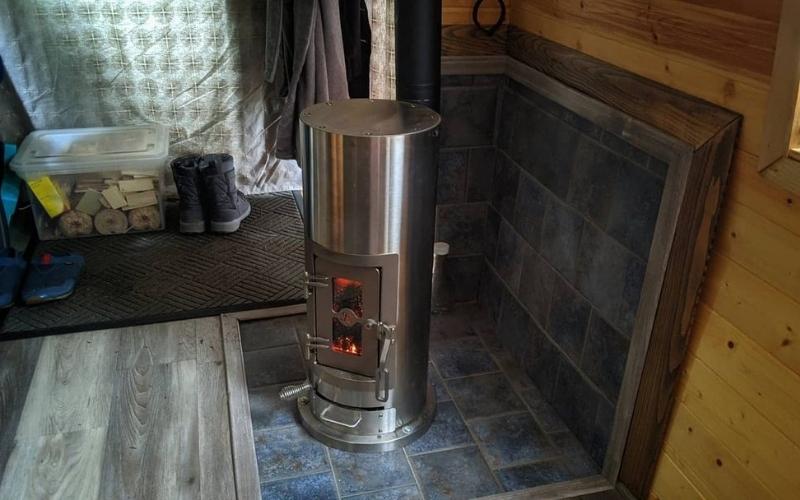
Method 3: Tap Into Natural Sources to Stay Warm
The same techniques that thousands of generations of early humans used before propane was around will work in your RV.
While these sources aren’t always around, or can be dangerous, they can provide a cost-free heating solution in the right hands.
Bring Marshmallows and a Wood Stove
Converting a fireplace’s comfort to suit your mobile home is as simple as connecting a ventilation pipe to the outside.
This option is best for RVer’s who have a bit of free space in their rig, as you need to give the stove enough space to prevent fire hazards.
If you can pull it off, you’ll be able to heat your RV with scrap wood and with no electricity required.
Try a DIY Solar Heater Solution
A simple heat grabber can convert electricity generated by photons in solar panels to warmth for your camper.
Heat Grabbers naturally heat cold air when hung from a window in the sun, and send that warm air throughout your vehicle.
This method won’t provide heat through the night, as it can’t store the hot air generated by the sun. Combining this option with proper insulation will offer a long-lasting heat solution.
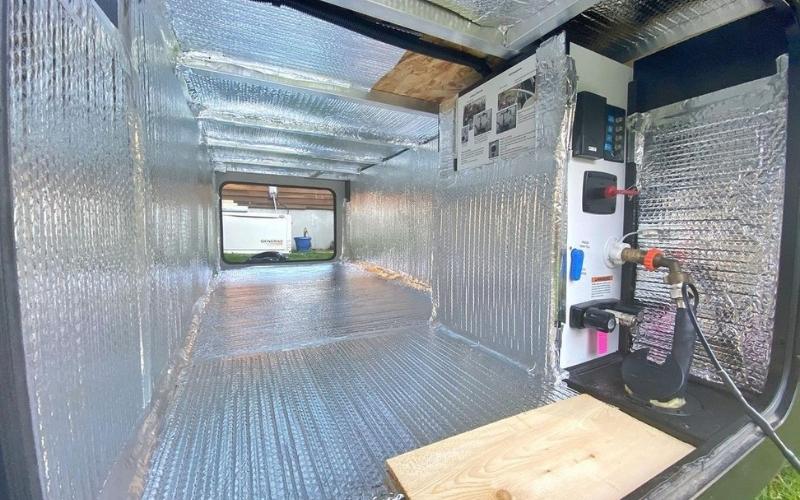
Method 4: The Nitty Gritty side of RV ownership; Insulation
No matter what option you employ to heat your camper, proper insulation will make your heating more energy-efficient and heat the space better.
Insulation works to keep hot air in your vehicle. Insulating any of the following areas where the air is known to escape your camper will make your heat last longer:
- Windows
- Floors
- Vents
- Doors
To properly insulate your RV, start by adding a layer of insulation behind every inch of your RV’s walls.
Any RV professionally built will have this feature, and this process should be the first step of your build-out process.
RV builders should wrap anything from plastic wrap to heavy-duty materials designed to insulate around any area where heat escapes your van and further protect your heat.
Providing a thin layer of airtight material in these four areas will allow your heating to go further.
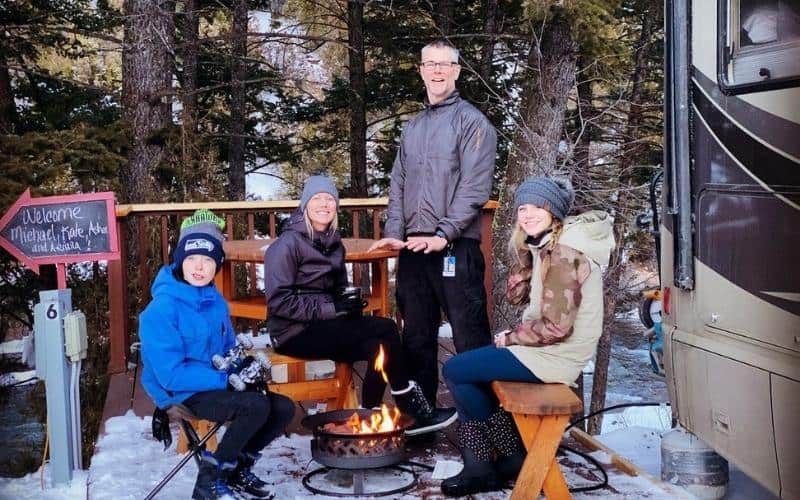
Method 5: Before You Can learn to Heat the Vehicle, You Must Heat yourself
Many permanent RV heat solutions involve shelling out thousands of dollars to renovate your RV. Take the heating process within yourself, and you may not need any extra heat.
Wear Warm Clothes, and Bring Plenty of Socks
Every inch matters when packing your entire life into a vehicle. It may seem wise to discard your warm clothing, which are sometimes the most cumbersome items in your closet.
Pick out the right gear that will keep you warm without filling up the cabinet to accompany you on your journey.
Dress smart for cold weather. Sometimes an extra sweater will do less than putting on a good pair of wool socks or a beanie.
Layer Blankets
Consider the temperatures you wish to camp at when you are packing your bedding. Bringing along a sleeping bag or heated blankets gives you a compact safety net.
If you are too cold, simply unpack your sleeping bag and slip it over your existing bedding.
Most modern sleeping bags are rated to keep you warm in subzero temperatures, giving you a serious boost.
Expect the Unexpected
Ideally, you’ll have an idea of what temperatures you plan on living in before you make your RV purchase.
There is no heating solution out there that is perfect for everyone; it is crucial to understand your personal goals when choosing what’s suitable for you.
Identify your comfort level when sleeping in the cold, and cross-exam that level with your budget.
If you plan on spending the winters in Florida, you won’t need the same level of protection someone traveling through Colorado would.
However, it can still snow in Florida, and it’s better to be safe than sorry. A few simple steps and extra items packed can completely change your mindset around weather anomalies.
Try a few different options to see what works best for you, and rest easy knowing your RV will stay nice and toasty.

